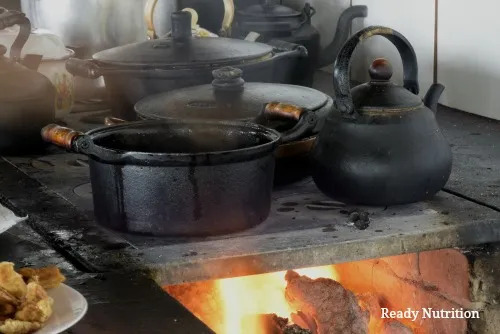Aside from using wood stoves to stay warm and cook food on, here are 10 tips you never knew on how to get the most out of your wood stove.
You recall I wrote one on wood stoves not too long ago, and I wanted to supplement this for a few more things you can do with yours. Aside from using wood stoves to stay warm and cook food on, here are a few tips you never knew on how to get the most out of your wood stove.
10 Ways to Make the Most of a Wood Stove
Ashes
One of the things you should consider is the potash that comes from your stove. Yes, all that wood turns into ashes that can be recycled and used. One of the things that you can do is to store them in a container (preferably a metal one that has a tightly-fitting lid) and use them later for producing your own soap. The ashes are boiled down in the water (yes, this too can be done on your wood stove!), and combined with lye and other ingredients.
Your ashes can also be used for metal polishing, for the likes of metals such as brass and silver. It works really well straight up or mixed with just a few drops of water. The ashes can also be combined with your compost piles and used as a form of fertilizer to replace many valuable minerals and nutrients that come from carboniferous materials being burned. Why do you suppose the new forest sprouts up in a few years after a forest fire? All of that burned wood goes into the soil and enriches it. You can turn it into your gardens when you’re planting in the springtime for the same effect.
Charcoal
Charcoal is another product that you can take from your wood stove. Used for a variety of things besides just cooking, charcoal can also be finely-crushed and added to your ash supply to make soap. It can be set aside for use as cooking material or a fire-starting ingredient and even used to clean teeth. Charcoal can also be used to filter water (see previous articles on water purification).
Soot
There’s also soot from the chimney (although you’ll probably have to wait until springtime to obtain it when you brush your chimney pipe). Soot is the black substance formed by the combustion of your wood in the stove. This is fine particulate matter that adheres to your pipe walls and is blackened, consisting mainly of carbon that has not been completely burned. Soot is responsible for many chimney fires. Soot can be mixed (in small quantities as needed) with a little bit of vegetable oil and some water to make your own ink. A type of soot is called lampblack and is used in enamels, paints, and inks from a commercial perspective.
That soot also has a great deal of unburned oils and resins in it (especially if you burn a lot of pine…don’t scoff…if you live in the Rockies, you will burn pine unless your last name is Rockefeller, believe me). The oils, resins, and unburned carbon are excellent to mix with things such as sawdust and lint, with some wax for fire starters for the wood stove or camping and backpacking.

Dehydrate Food
The top of the stove is great for dehydrating food as well. You have recipes from ReadyNutrition for pemmican and jerky. You can make your own on top of the stove with small-aperture wire racks…of the type to cool off hot sandwiches and the like. Lay your meat on top of the wood stove top on the racks and allow that heat to dry them right out.
We’d love to hear any suggestions of things that you have found to do with your wood stoves (along with heating your home and cooking, of course). It is all part of your preps and homesteading and learning to economize and obtain the maximum use for all of the materials you have at your disposal. Explore some of these and let us know what you think, as well as things you have discovered on your own. Keep up that good fight, drink a good cup of coffee, and stay warm!
source : Jeremiah Johnson



